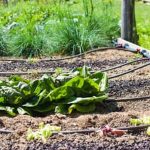Have you ever heard of upside down gardening? In this article, we will explore how to plant vegetables using the unique technique of upside down gardening. This innovative approach to gardening offers numerous benefits and can be a great option for those with limited space or mobility issues.
Upside down gardening involves growing vegetables in containers suspended from above rather than planting them in the ground. This method not only saves space but also minimizes the risk of pests and diseases, making it an attractive option for many gardeners. Additionally, growing vegetables upside down can result in higher yields and easier maintenance.
When considering which vegetables to grow using the upside down method, it is important to choose varieties that are well-suited for this type of growing. Factors such as size, weight, and root structure should be carefully considered when selecting vegetables for upside down gardening. With proper planning and the right choices, anyone can successfully grow their favorite vegetables using this unconventional yet highly effective approach.
Choosing the Right Vegetables for Upside Down Gardening
When it comes to choosing the right vegetables for upside down gardening, there are several factors to consider. The most important consideration is the size and weight of the vegetables. Root vegetables, such as carrots and radishes, may not be suitable for upside down gardening due to their size and how they grow. On the other hand, smaller and lighter vegetables like cherry tomatoes, peppers, and certain herbs are well-suited for this innovative gardening method.
Here are some of the best vegetables for upside down gardening:
- Cherry tomatoes
- Peppers
- Strawberries
- Herbs (such as basil, oregano, and mint)
These vegetables are ideal for upside down gardening because they are relatively small in size and do not put too much strain on the plant’s root system when grown upside down. Additionally, they tend to thrive in confined spaces, making them perfect candidates for hanging planters or containers.
When choosing vegetables for upside down gardening, it’s also important to consider the amount of sunlight they require. Make sure to select vegetables that are suitable for your specific growing conditions and climate. Ensure that you have a clear understanding of each vegetable’s needs before starting your upside-down garden.
Lastly, consider the overall aesthetic appeal of your chosen vegetables. Select a variety of colorful plants that will not only thrive when grown upside down but also add beauty to your outdoor space. With careful consideration of these factors, you can successfully choose the right vegetables for your upside down garden.
Selecting the Right Containers for Upside Down Gardening
Different Types of Containers for Upside Down Gardening
may include hanging baskets, plastic buckets, or specialized upside down planters. Hanging baskets are a popular choice due to their ability to be easily hung up, while plastic buckets are sturdy and provide ample space for root growth.
Tips for Choosing the Right Size and Material for Containers
are important to ensure that your vegetables have enough space to grow and thrive. Consider the full-grown size of the vegetable when selecting a container, ensuring that it has enough room for both the root system and the foliage. The material of the container is also important – plastic containers are lightweight and easy to move, while clay or ceramic pots may add an aesthetic appeal but can be heavier.
When choosing a container for your upside down gardening, consider factors such as durability, drainage holes, and overall weight once soil and plants are added. It’s important to select a container that will provide adequate support for your vegetables while also being practical for your gardening setup.
By carefully selecting the right containers for your upside down gardening project, you’ll set yourself up for success in growing healthy and flourishing vegetables in an unconventional way that optimizes space and promotes efficient growth.
With these tips in mind, you can confidently choose the best containers for your upside down gardening venture.
Preparing the Soil and Planting Medium
Upside down gardening is a unique and innovative way of growing vegetables that has gained popularity in recent years. This method involves planting vegetables in containers suspended upside down, allowing gravity to work in favor of the plants. One of the key factors to ensure the success of upside down gardening is preparing the soil and choosing the right planting medium for your vegetables.
When it comes to preparing the soil for upside down gardening, it is essential to use a high-quality potting mix that is well-draining and rich in nutrients. The soil should be loose and airy to allow for proper root growth and drainage. Additionally, adding compost or fertilizer to the soil can provide additional nutrients for the plants as they grow.
In terms of selecting the right planting medium, coconut coir or peat moss are excellent options for upside down gardening. These materials are lightweight, retain moisture well, and provide good aeration for the plant roots. When combined with perlite or vermiculite, they create an ideal growing environment for vegetables in upside down containers.
To prepare your soil and planting medium for upside down gardening, follow these tips:
- Use a high-quality potting mix that is well-draining and nutrient-rich
- Consider adding compost or fertilizer to boost nutrient levels in the soil
- Choose lightweight materials such as coconut coir or peat moss for your planting medium
- Mix in perlite or vermiculite to improve drainage and provide aeration for plant roots
By following these tips and preparing your soil and planting medium properly, you can set your upside down garden up for success from the very beginning.
Planting Techniques for Upside Down Gardening
Step-by-Step Instructions
When it comes to planting vegetables using the upside down gardening method, there are some specific steps that should be followed for successful growth. First, choose a suitable container and fill it with moistened planting medium. Then, carefully insert the seedling or plant through the bottom hole of the container and secure it in place by adding more planting medium. Make sure to water thoroughly after planting to ensure that the roots are properly hydrated.
After planting, it is important to hang the containers in a location that receives adequate sunlight for the specific vegetables being grown. Proper positioning is crucial for the development and growth of upside down plants. Pay attention to how your plants are growing and adjust their position accordingly if they need more or less sun exposure.
Tips for Ensuring Successful Planting
One important aspect of successful upside down gardening is choosing vegetables that are well-suited for this method. Tomatoes, peppers, cucumbers, and certain herbs are popular choices due to their ability to thrive when planted upside down. It is also important to consistently monitor the moisture levels of the soil in the containers as these can dry out quickly.
Additionally, regular pruning and maintenance will help ensure healthy growth and productivity from your upside down garden. By following these planting techniques and tips, even beginner gardeners can experience success with this unique gardening method.
Ensuring Proper Drainage
Good drainage is essential when planting vegetables upside down. It’s important to select containers with adequate drainage holes to prevent waterlogged soil, which can lead to root rot and other issues. When preparing the soil and planting medium, mix in some perlite or coarse sand to improve drainage and aeration within the container. This will help promote healthy root development and overall plant growth in an upside down garden.
Caring for Upside Down Vegetables
Once you have successfully planted your vegetables upside down, it is important to provide them with the proper care to ensure a bountiful harvest. One of the most crucial aspects of caring for upside down vegetables is watering.
Since gravity works against you in this type of gardening, it’s important to water your plants regularly. This can be a bit challenging, but using a watering can with a long spout or a drip irrigation system can make it easier to reach the roots of your plants.
In addition to watering, fertilization is also essential for the health and growth of your upside down vegetables. Choose a balanced fertilizer and apply it according to the specific needs of the vegetables you are growing. Regularly inspecting your plants for signs of pests and disease is also important in upside down gardening. Since the plants are suspended off the ground, they may be less susceptible to certain pests but more prone to others, so vigilance is key.
Another important aspect of caring for upside down vegetables is pruning. As your plants grow, you may need to trim back certain branches or leaves to promote healthy growth and prevent overcrowding. This will ensure that each vegetable receives enough sunlight and airflow for optimal development.
Below is an example of relevant data from my reply presented in a HTML table.
| Aspect | Care Tips |
|---|---|
| Watering | Regularly water with long-spouted watering can or drip system |
| Fertilization | Apply balanced fertilizer based on vegetable needs |
Harvesting and Pruning Upside Down Vegetables
Once you’ve successfully planted your vegetables upside down, it’s important to know when and how to harvest them for optimal results. One of the advantages of upside down gardening is that it can provide protection from certain pests and diseases, making the vegetables cleaner and easier to harvest. When the vegetables are ready to be harvested, carefully remove them from the container, taking care not to damage the plant in the process.
Pruning is also an essential aspect of caring for upside down vegetables. Regular pruning helps maintain healthy plants by removing any dead or damaged foliage, promoting air circulation, and preventing disease. It’s important to use sharp, clean pruning shears to make clean cuts without causing unnecessary stress to the plants.
In addition to harvesting and pruning, it’s crucial to regularly monitor your upside down vegetables for any signs of pests, diseases, or nutrient deficiencies. By staying vigilant and addressing these issues promptly, you can help ensure a bountiful harvest of healthy and delicious homegrown produce.
| Aspect | Detail |
|---|---|
| Harvesting Technique | Carefully remove vegetables from the container without damaging the plant. |
| Pruning Importance | Maintains healthy plants by removing dead or damaged foliage and promoting air circulation. |
| Pest Monitoring | Regularly check for signs of pests, diseases, or nutrient deficiencies. |
Troubleshooting Common Issues in Upside Down Gardening
Upside down gardening can be a unique and innovative way to grow vegetables, but like any gardening method, it comes with its own set of challenges. Common issues that may arise in upside down gardening include poor drainage, inadequate sunlight, and inadequate support for heavier vegetables.
One common issue in upside down gardening is poor drainage, which can lead to root rot and other problems. To avoid this issue, it is important to choose the right containers for your upside down garden. Look for containers with sufficient drainage holes to ensure that excess water can escape easily. Additionally, selecting a well-draining planting medium can help prevent waterlogged soil.
Another potential issue in upside down gardening is inadequate sunlight reaching the plants. Since the plants are growing upside down, it is important to ensure that they receive enough sunlight for healthy growth. Be sure to place your containers in a location that receives at least 6-8 hours of direct sunlight each day, and consider using reflective materials to maximize light exposure.
Finally, some vegetables grown through upside-down gardening can become quite heavy as they mature, leading to potential issues with support and stability. To prevent this problem, choose sturdy containers made of durable materials such as plastic or metal. Additionally, consider providing additional support for heavier vegetables by using stakes or trellises as needed.
By addressing these common issues and following best practices for upside-down gardening, you can overcome potential challenges and enjoy a successful harvest of fresh vegetables grown in an unconventional yet rewarding manner. With proper planning and care, upside down gardening can be a fun and fruitful way to cultivate your favorite vegetables at home.
For more information on how to plant vegetables using upside down gardening techniques or troubleshooting any problems that may arise along the way while growing your garden in this style always consult reliable resources from experienced gardeners or reputable sources on the topic.
Conclusion
Are you looking for a unique and space-saving way to grow your own vegetables? Upside down gardening might be the perfect solution for you. This method of growing vegetables involves planting them in containers that are hung upside down, allowing the plants to grow downwards instead of upwards.
Not only does this save space, but it can also help prevent pests and diseases from affecting your crops. In addition, upside down gardening can be a fun and creative way to add greenery to your outdoor living space.
When choosing which vegetables to grow upside down, it’s important to select varieties that are well-suited to this method of gardening. Tomatoes, peppers, cucumbers, and strawberries are some popular choices for upside down gardening due to their ability to thrive when planted in hanging containers. Additionally, it’s essential to consider factors such as the weight of the vegetable and its root system when deciding on what to plant.
Selecting the right containers for your upside down garden is crucial for success. There are various types of containers available, including specialized upside down planters or DIY options such as buckets or plastic bottles. It’s important to choose a container that is sturdy enough to support the weight of the plant and has adequate drainage holes. Consider the material and size of the container as well, as these factors can impact the overall health and growth of your vegetables.
Learning how to plant vegetables using upside down gardening techniques can be an exciting adventure for any gardener. By following step-by-step instructions and incorporating proper care techniques, you can look forward to harvesting bountiful crops all while enjoying this innovative garden style. Whether you’re limited on space or simply want an alternative way of growing your own produce, upside down gardening is definitely worth trying out.
Additional Resources for Upside Down Gardening
In conclusion, upside-down gardening is a unique and innovative way to grow vegetables that can yield great results for gardeners of all levels. By choosing the right vegetables, containers, and soil, and following proper planting techniques and maintenance tips, you can enjoy a bountiful harvest from your upside-down garden.
One of the key factors in achieving success with upside-down gardening is selecting the right vegetables for this growing method. Consider factors such as plant size, root structure, and sunlight requirements when choosing which vegetables to grow upside down. With careful consideration and planning, you can enjoy a variety of fresh produce from your upside-down garden.
As with any type of gardening, proper care and maintenance are crucial for the success of your upside-down garden. From watering techniques to fertilization and pruning, it’s important to stay attentive to the needs of your plants in order to ensure their healthy growth and production. With patience and dedication, you can overcome common issues that may arise in upside-down gardening and reap the rewards of your hard work.
Frequently Asked Questions
What Vegetable Plants Can You Grow Upside Down?
You can grow a variety of vegetable plants upside down, including tomatoes, peppers, cucumbers, and even certain types of squash. These plants do well in upside down gardens due to their vine-like growth.
How Do You Start an Upside Down Garden?
To start an upside down garden, you will need to choose a location that receives plenty of sunlight. Then, you’ll need to acquire or make your own upside down planters using buckets or specially designed containers. Once you have the planters, fill them with soil and secure the plants into the bottom holes of the planter.
How Do You Plant Tomatoes in an Upside Down Planter?
Planting tomatoes in an upside down planter involves carefully inserting the tomato plant through the hole in the bottom of the planter and then adding a layer of newspaper or a coffee filter over the soil before adding more soil on top. This helps keep everything in place while allowing water to penetrate.
Finally, hang your planter in a sunny location and water regularly for best results.

If you’re looking to get into vegetable gardening, or are just looking for some tips on how to make your current garden better, then you’ve come to the right place! My name is Ethel and I have been gardening for years. In this blog, I’m going to share with you some of my best tips on how to create a successful vegetable garden.





